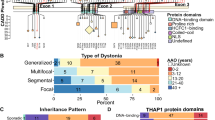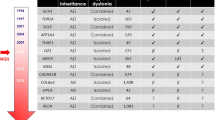Abstract
Specific mutations in COL6A3 have recently been reported as the cause of isolated recessive dystonia, which is a rare movement disorder. In all patients, at least one mutation was located in Exons 41 and 42. In an attempt to replicate these findings, we assessed by direct sequencing the frequency of rare variants in Exons 41 and 42 of COL6A3 in 955 patients with isolated or combined dystonia or with another movement disorder with dystonic features. We identified nine heterozygous carriers of rare variants including five different missense mutations and an extremely rare synonymous variant. In these nine patients, we sequenced the remaining 41 coding exons of COL6A3 to test for a second mutation in the compound heterozygous state. In only one of them, a second rare variant was identified (Thr732Met + Pro3082Arg). Of note, this patient had been diagnosed with Parkinson´s disease (with dystonic posturing) due to homozygous PINK1 mutations. The COL6A3 mutations clearly did not segregate with the disease in the four affected siblings of this family. Further, there was no indication for a disease-modifying effect of the COL6A3 mutations since disease severity or age at onset did not correlate with the number of COL6A3 mutated alleles in this family. In conjunction with the relatively high frequency of homozygous carriers of reported mutations in publically available databases, our data call a causal role for variants in COL6A3 in isolated dystonia into question.

Similar content being viewed by others
References
Albanese A, Bhatia K, Bressman SB et al (2013) Phenomenology and classification of dystonia: a consensus update. Mov Disord 28:863–873
Lohmann K, Klein C (2013) Genetics of dystonia: what’s known? What’s new? What’s next? Mov Disord 28:899–905
Khan NL, Wood NW, Bhatia KP (2003) Autosomal recessive, DYT2-like primary torsion dystonia: a new family. Neurology 61:1801–1803
Charlesworth G, Angelova PR, Bartolome-Robledo F et al (2015) Mutations in HPCA cause autosomal-recessive primary isolated dystonia. Am J Hum Genet 96:657–665
Zech M, Lam DD, Francescatto L et al (2015) Recessive mutations in the alpha3 (VI) collagen gene COL6A3 cause early-onset isolated dystonia. Am J Hum Genet 96:883–893
Gould DB, Phalan FC, Breedveld GJ et al (2005) Mutations in Col4a1 cause perinatal cerebral hemorrhage and porencephaly. Science 308:1167–1171
Bonnemann CG (2011) The collagen VI-related myopathies: muscle meets its matrix. Nat Rev Neurol 7:379–390
Hedrich K, Hagenah J, Djarmati A et al (2006) Clinical spectrum of homozygous and heterozygous PINK1 mutations in a large German family with Parkinson disease: role of a single hit? Arch Neurol 63:833–838
Kircher M, Witten DM, Jain P et al (2014) A general framework for estimating the relative pathogenicity of human genetic variants. Nat Genet 46:310–315
Steeves TD, Day L, Dykeman J, Jette N, Pringsheim T (2012) The prevalence of primary dystonia: a systematic review and meta-analysis. Mov Disord 27:1789–1796
Acknowledgments
We are grateful to all participants in this study.
Author information
Authors and Affiliations
Corresponding author
Ethics declarations
Funding
This study was supported by funding from the German Research Foundation (LO1555/8-1 to K.L.). S.Z. is supported by an intramural grant of the University of Luebeck (E36-2014). She received honoraria for lectures from St. Jude Medical. A.A.K. and P.K. are supported by the German Research Foundation (KFO247). H.-C.J. has received funding from the Dystonia Coalition (NS065701; The Dystonia Coalition is part of the NIH Rare Diseases Clinical Research Network and has support from the NIH Office of Rare Diseases Research and National Institute of Neurological Disorders and Stroke). S.J.C. is supported by a grant of the Korea Healthcare Technology R & D Project, Ministry of Health & Welfare, Republic of Korea (HI14C2206). A.M. is supported by the Possehl Foundation (Lübeck, Germany) and the Dystonia Coalition (USA). C.K. is a recipient of a career development award from the Herman and Lilly Schilling Foundation.
Conflict of interest statement
None of the authors declares any conflict of interest.
Additional information
K. Lohmann and F. Schlicht contributed equally to this study.
Rights and permissions
About this article
Cite this article
Lohmann, K., Schlicht, F., Svetel, M. et al. The role of mutations in COL6A3 in isolated dystonia. J Neurol 263, 730–734 (2016). https://doi.org/10.1007/s00415-016-8046-y
Received:
Revised:
Accepted:
Published:
Issue Date:
DOI: https://doi.org/10.1007/s00415-016-8046-y




